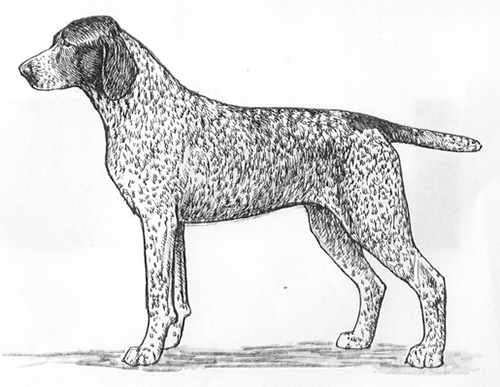Braque Francais de Grande Taille
Gun Dog Group
The goals and purposes of this breed standard include: to furnish guidelines for breeders who wish to maintain the quality of their breed and to improve it; to advance this breed to a state of similarity throughout the world; and to act as a guide for judges.
Breeders and judges have the responsibility to avoid any conditions or exaggerations that are detrimental to the health, welfare, essence and soundness of this breed, and must take the responsibility to see that these are not perpetuated.
Any departure from the following should be considered a fault, and the seriousness with which the fault should be regarded should be in exact proportion to its degree and its effect upon the health and welfare of the dog and on the dog’s ability to perform its traditional work.
History
There are two types of French Pointing Dogs: the large size, which are known as the Gascogne type; and the smaller size, which are known as the Pyrenean type. The Braque Francais, De Grande Taille is a large sized Gascogne type breed, originally from the Southwest of France and the Central Pyrenees.
The Braque Francais De Grande Taille was recognized by the United Kennel Club in 2006.
General Appearance
A Braque type pointing dog of medium proportions and noble appearance, powerful, strong and robust but not overly heavy. The females are finer. The skin is supple and loose.
Head
Substantial, but not too heavy.
SKULL
Almost flat or very slightly rounded, with a slight median furrow. No prominence of occiput. The stop is moderate.
MUZZLE
Somewhat shorter than the skull. Broad and rectangular, sometimes convex in profile. The toplines of the skull and muzzle are slightly divergent. The lips are pendant.
TEETH
The Braque Francais, De Grande Taille has a complete set of evenly spaced, white teeth meeting in a scissors or level bite.
Disqualifications: Overshot or undershot bite.
NOSE
Broad, brown in color, with well opened nostrils.
Disqualification: Split nose. Pronounced lack of pigment on the nose.
EYES
Deeply set and well opened, with a frank expression. Chestnut brown or dark yellow in color.
Disqualifications: Entropion, ectropion, or pink spots on the eyelids.
EARS
Medium length, set at eye level, and not too broad at the base. Slightly folded, and rounded at the tips. Must reach to the rear edge of the nose leather.
Neck
Of good length and slightly arched. There is always a slight dewlap.
Forequarters
The shoulders are very muscular, and moderately oblique. The upper arm is strong and well muscled.
FORELEGS
Long, straight and vertical.
Body
The chest is broad and deep to the elbow. The ribs are well rounded. The back is strong and straight, sometimes a bit long, but always well supported. The loin is short, muscular and slightly arched. The croup is slightly oblique. The belly is flat with only slight tuck up.
Hindquarters
Very straight and vertical, with fleshy, muscular thighs. The hocks are moderately angulated and the rear pasterns are short.
Feet
Nearly round with tight, well arched toes. The nails are strong and the pads are thick and fleshy.
Tail
Set off the natural line of the croup. Generally docked, but a natural tail or a natural bob are not a fault.
Disqualification: Complete absence of a tail.
Coat
Rather thick and well furnished, finer on the head and ears.
Color
Chestnut brown, either solid or mixed with white. With or without ticking or roaning or tan markings.
Height
Height at the withers for males is 23 inches to 27 inches. For females, it is 22 inches to 26.5 inches. Preferred size is 24-25 inches.
Disqualifications
(A dog with a Disqualification must not be considered for placement in a conformation event, and must be reported to UKC.)
Unilateral or bilateral cryptorchid.
Viciousness or extreme shyness.
Albinism.
Overshot or undershot bite.
Split nose.
Pronounced lack of pigment on the nose.
Entropion, ectropion, or pink spots on the eyelids.
Complete absence of a tail.
The docking of tails and cropping of ears in America is legal and remains a personal choice. However, as an international registry, the United Kennel Club is aware that the practices of cropping and docking have been forbidden in some countries. In light of these developments, the United Kennel Club feels that no dog in any UKC event, including conformation, shall be penalized for a full tail or natural ears.

Looking for a Dog?
Find a dog that will fit your family.
Note: The breeders on this list are not endorsed by UKC.
©Copyright 2006, United Kennel Club
